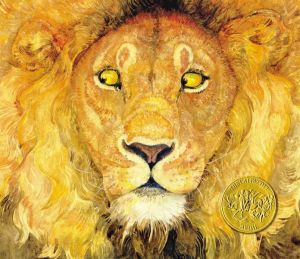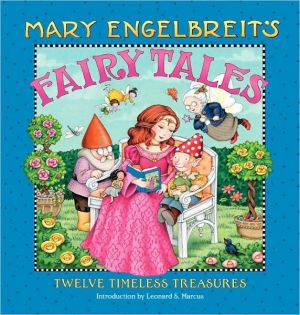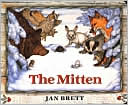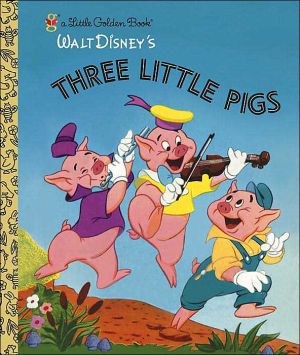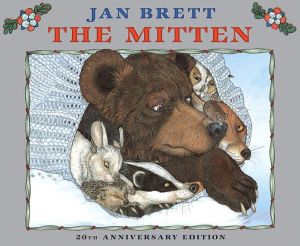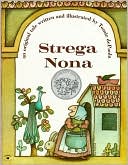The Lion and the Mouse
In award-winning artist Jerry Pinkney's wordless adaptation of one of Aesop's most beloved fables, an unlikely pair learn that no act of kindness is ever wasted. After a ferocious lion spares a cowering mouse that he'd planned to eat, the mouse later comes to his rescue, freeing him from a poacher's trap. With vivid depictions of the landscape of the African Serengeti and expressively-drawn characters, Pinkney makes this a truly special retelling, and his stunning pictures speak volumes.\ \...
Search in google:
In award-winning artist Jerry Pinkney's wordless adaptation of one of Aesop's most beloved fables, an unlikely pair learn that no act of kindness is ever wasted. After a ferocious lion spares a cowering mouse that he'd planned to eat, the mouse later comes to his rescue, freeing him from a poacher's trap. With vivid depictions of the landscape of the African Serengeti and expressively-drawn characters, Pinkney makes this a truly special retelling, and his stunning pictures speak volumes.The Barnes & Noble ReviewThe award-winning illustrator Jerry Pinkney exceeds all expectations with this almost wordless retelling of Aesop's fable about a mouse who repays a lion's mercy by gnawing the fibers of a snare that entraps him. Pinkney sets this timeless tale in the African Serengeti, populating the pages with the flora and fauna of the region. This unique ecosystem -- joining marshland with plains -- seem to glow with gold and green, for Pinkney's watercolors are infused with translucent light. His extensive research into the Serengeti is apparent without being overwhelming, bringing to life details from tiny ants to a camouflaged amphibians resting in the native grasses. A panorama of African animals -- lion lounging front and center -- immediately set the scene in the front endpapers, while the title page displays the other featured player, the mouse, whose miniscule size is emphasized as it perches in the dried mud of the lion's paw print. Pinkney's page-turns have a cinematic quality: we first view the landscape from behind the mouse from her point-of-view, low to the ground as the sun rises on the plains. Frightened by a hunting owl, she leaps beyond the frame into further danger, disturbing the lion at rest. The only words that interrupt this purely visual storytelling are hand-lettered animal sounds so that the readers can squeak, shriek and roar along with the animals. The result should delight all ages -- even the youngest can glean that the tiniest among us can be of service, that no act of kindness is wasted and that small acts have large repercussions. An exquisite detail that should not be missed: if one peeks behind the dust jacket there a bonus painting on the back cover -- an homage to Edward Hicks's Peaceable Kingdom recast with the animals of the Serengeti. --Lisa Von Drasek
\ From Barnes & NobleSometimes acts of kindness require no words at all. Jerry Pinkney's Lion & the Mouse gracefully proves that point by wordlessly retelling Aesop's timeless fable about an odd animal couple who built a friendship. A most valuable playgroup lesson for kind hearts.\ \ \ \ \ Roger SuttonThe art of Jerry Pinkney's new picture book is commanding enough to do without the author's name or even the title on the front cover…Winner of five Caldecott Honors, Pinkney has always seemed happier drawing animals than people. Look, in his 2007 retelling, at his studied Little Red Riding Hood next to his lively Wolf. His beasts are not humans in disguise; while both the lion and the mouse have emotions and intelligence in their eyes, they are animal in nature. We don't know why the lion lets the mouse go free or why the mouse nibbles the lion out of the net planted by the men (poachers? wardens?) from the jeep. But it's actions in this case that count. That's the moral of the story.\ —The New York Times\ \ \ Kristi Jemtegaard…[a] beautiful new rendition of…Aesop's fable…Readers unfamiliar with the tale will easily understand it from the carefully sequenced images; those who have already encountered it will experience it anew.\ —The Washington Post\ \ \ \ \ Publishers WeeklyOther than some squeaks, hoots and one enormous roar, Pinkney's (Little Red Riding Hood) interpretation of Aesop's fable is wordless—as is its striking cover, which features only a head-on portrait of the lion's face. Mottled, tawny illustrations show a mouse unwittingly taking refuge on a lion's back as it scurries away from an owl. The large beast grabs and then releases the tiny creature, who later frees the lion who has become tangled in a hunter's snare. Pinkney enriches this classic tale of friendship with another universal theme—family—affectingly illustrated in several scenes as well as in the back endpapers, which show the lion walking with his mate and cubs as the mouse and her brood ride on his back. Pinkney's artist's note explains that he set the book in Africa's Serengeti, “with its wide horizon and abundant wildlife so awesome yet fragile—not unlike the two sides of each of the heroes.” Additional African species grace splendid panoramas that balance the many finely detailed, closeup images of the protagonists. Pinkney has no need for words; his art speaks eloquently for itself. Ages 3–6. (Sept.)\ \ \ \ \ Children's Literature\ - Ken Marantz and Sylvia Marantz\ Here, Pinkney is audacious, courageous, or simply imaginative enough to retell the classic Aesop fable without text. Very few natural sound effects like the hoot of an owl, the scratching of the mouse's teeth as it chews the ropes and the "RRRRRROAARRRR" of the captured lion are all that are necessary. His animated renderings of the African animals along with the two hunters draw us immediately into the familiar story. Even the paper jacket is textless; the title is only on the spine. The front of the book's actual cover introduces the two main characters in portraits, with only "&" in between and the name of the illustrator. The back of the cover and the front end pages offer different pictures of the lion amid the other animals. The rear end pages visualize the happy ending with the lion family strolling along and the mouse family riding on the lion's back. The illustrations range from double-page spreads to framed or unframed images on single pages. They vary in size but not intensity. The close-up of the lion in the trap is almost a psychological study. As a master of the media, Pinkney handles pencil and transparent watercolors with added colored pencils to create naturalistic characters while avoiding the strictures of photorealism. This is a stunning tour de force. A note from Pinkney discusses his relation to the story and his reasons for this version. Reviewer: Ken Marantz and Sylvia Marantz\ \ \ \ \ School Library JournalPreS-Gr 3—This story starts on the cover with the glorious, golden countenance of a lion. No text is necessary to communicate the title: the direction of the beast's gaze and the conflicted expression on his tightly cropped face compel readers to turn the book over, where a mouse, almost filling the vertical space, glances back. The endpapers and artist's note place these creatures among the animal families of the African Serengeti. Each spread contributes something new in this nearly wordless narrative, including the title opening, on which the watchful rodent pauses, resting in one of the large footprints that marches across the gutter. In some scenes, Pinkney's luminous art, rendered in watercolor and colored pencil, suggests a natural harmony, as when the cool blues of the sky are mirrored in the rocks and acacia tree. In other compositions, a cream-colored background focuses attention on the exquisitely detailed and nuanced forms of the two main characters. Varied perspectives and the judicious use of panels create interest and indicate time. Sounds are used sparingly and purposefully—an owl's hoot to hint at offstage danger or an anguished roar to alert the mouse of the lion's entrapment. Contrast this version with Pinkney's traditional treatment of the same story (complete with moral) in Aesop's Fables (North-South, 2000). The ambiguity that results from the lack of words in this version allows for a slower, subtle, and ultimately more satisfying read. Moments of humor and affection complement the drama. A classic tale from a consummate artist.—Wendy Lukehart, Washington DC Public Library\ \ \ \ \ Kirkus ReviewsA nearly wordless exploration of Aesop's fable of symbiotic mercy that is nothing short of masterful. A mouse, narrowly escaping an owl at dawn, skitters up what prove to be a male lion's tail and back. Lion releases Mouse in a moment of bemused gentility and-when subsequently ensnared in a poacher's rope trap-reaps the benefit thereof. Pinkney successfully blends anthropomorphism and realism, depicting Lion's massive paws and Mouse's pink inner ears along with expressions encompassing the quizzical, hapless and nearly smiling. He plays, too, with perspective, alternating foreground views of Mouse amid tall grasses with layered panoramas of the Serengeti plain and its multitudinous wildlife. Mouse, befitting her courage, is often depicted heroically large relative to Lion. Spreads in watercolor and pencil employ a palette of glowing amber, mouse-brown and blue-green. Artist-rendered display type ranges from a protracted "RRROAARRRRRRRRR" to nine petite squeaks from as many mouselings. If the five cubs in the back endpapers are a surprise, the mouse family of ten, perched on the ridge of father lion's back, is sheer delight. Unimpeachable. (author's note) (Picture book. 3-6)\ \ \ \ \ The Barnes & Noble ReviewThe award-winning illustrator Jerry Pinkney exceeds all expectations with this almost wordless retelling of Aesop's fable about a mouse who repays a lion's mercy by gnawing the fibers of a snare that entraps him. Pinkney sets this timeless tale in the African Serengeti, populating the pages with the flora and fauna of the region. This unique ecosystem -- joining marshland with plains -- seem to glow with gold and green, for Pinkney's watercolors are infused with translucent light. His extensive research into the Serengeti is apparent without being overwhelming, bringing to life details from tiny ants to a camouflaged amphibians resting in the native grasses. A panorama of African animals -- lion lounging front and center -- immediately set the scene in the front endpapers, while the title page displays the other featured player, the mouse, whose miniscule size is emphasized as it perches in the dried mud of the lion's paw print. Pinkney's page-turns have a cinematic quality: we first view the landscape from behind the mouse from her point-of-view, low to the ground as the sun rises on the plains. Frightened by a hunting owl, she leaps beyond the frame into further danger, disturbing the lion at rest. The only words that interrupt this purely visual storytelling are hand-lettered animal sounds so that the readers can squeak, shriek and roar along with the animals. The result should delight all ages -- even the youngest can glean that the tiniest among us can be of service, that no act of kindness is wasted and that small acts have large repercussions. An exquisite detail that should not be missed: if one peeks behind the dust jacket there a bonus painting on the back cover -- an homage to Edward Hicks's Peaceable Kingdom recast with the animals of the Serengeti. --Lisa Von Drasek\ \
